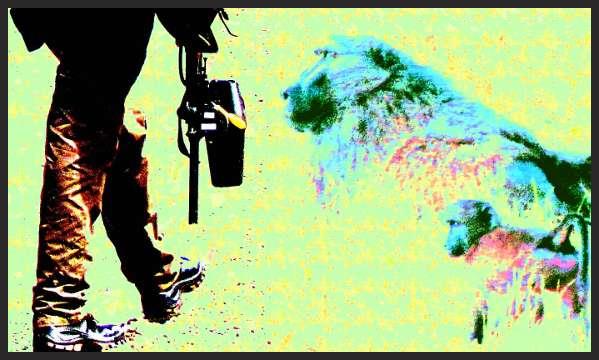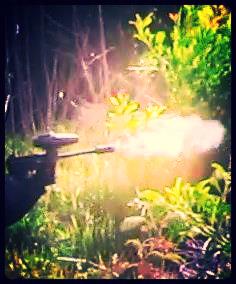Following controversial recommendations by local researchers giving input to baboon management, aggressive 'Tools' are used to chase the Peninsula baboons. If they are deemed resistant to these tools they are killed.

Computer graphic
Pain aversion tools like paintballing were adopted into all 11 managed baboon troops in July 2012 on the recommendation of the head of a local baboon research unit (BRU) who argued that baboons being in the urban area and hurt by residents was tantamount to a 'decrease in their welfare'.
His argument essentially went, that for their own "welfare" baboons should be chased from the urban area with pain aversion tools. On this argument, the animal welfare associations, NSPCA and SPCA, agreed to allow aggressive tools to be used.
(They had previously strongly opposed the 'noise aversion tools' of bullwhips and bearbangers the head of the unit had argued for since 2009. Despite their disapproval these had attempted to be introduced into troops on various occasions.)
However, in reality, with the introduction of pain aversion 'tools' baboons have been hurt on a daily basis as they are shot at at any time of the day, throughout the day.
Residents observing the process comment baboons are 'harassed', 'terrified', 'hunted' also alleging they have observed baboons shot at from a close range.
Baboons not only continue to come into the urban areas and get hurt by residents and dogs (in the case of the Da Gama troops, they often still sleep in the urban area and are shot out from there by rangers in the mornings).
At the same time there has also been a rise in official culling of baboons for raiding since this strategy was introduced in 2009. Around 40 baboons have been killed, around 30 since 2012.
Culling baboons is euphemistically referred to as "humane euthanasia". The argument put forward by researchers involved is that it is preferable for the animals to be humanely euthanised than suffer retributive killing by residents.
(After the baboons die, they are taken to the research unit. Fred, the well known Smitswinkel alpha male featured in Baboons with Bill Bailey was controversially culled for raiding in 2011, then subsequently reappeared being dissected in a TV special of Nature's Giants entitled "Rogue baboon" with the head of the research unit present and also offering comments.)
According to December 2012 Version 5 of the SOPs, pepperballs, pepperspray, rubberballs and plastic balls are permitted. (While initially only males were to be shot at, females as well as juveniles of a certain size can be targeted.)
Residents and monitors (many of whom were subsequently fired) were shocked to see the baboons being paintballed. (Residents were not informed ahead of time that paintballers called rangers would be racing around their streets shooting at the baboons.)
Many have likened the process to hunting. Their objections are ignored.
Instead, residents not supporting the use of these aggressive methods, were accused by service provider staff of causing 'harrassment' and were themselves 'targeted' by paintballing supervisors/management by various means.
Incidents were reported by residents of some supervisory staff threatening residents and using various intimidatory actions, seemingly to attempt to prevent either the observation or recording of the paintballing process.
Residents were exposed to false accusations including purposefully feeding baboons, threats of legal action, attempts to restrict their movements in public streets in an effort to prevent them watching or photographing baboons and therefore potentially the paintballing. (Prior to the introduction of paintballing, the two previous service providers who used shouts and whistles to herd the baboons had never objected to residents or visitors watching or photographing baboons or staff in their proximity.)
Due to the temperamental volatility of some supervisory staff, residents also wondered if they should even be permitted to handle a paintball gun, especially since they were shooting around children and pets in the residential area.
For a number of the operators working since July 2012 it was their first time in the field shooting a paintball gun after brief training. Their inexperience was evident, one describing it as a 'steep learning curve', another admitting to shooting himself in the foot soon after starting the job. Others downplayed the effect of the guns by saying they were toys children played with. Or stated they were "conservationists" who "loved" the baboons.
An NSPCA representative stated in a public meeting in November 2012 that any SOPs are only as good as the operator.
Yet if there is little independent monitoring of the shooting and service provider supervisory staff aggressively oppose their actions being scrutinized including by residents, these simply continue to occur unchecked thus also undermining the baboons' welfare.
While many residents do not agree with the pain aversion methods adopted on the recommendation of the research unit, it should be noted that scientists (including co-founders of the unit) and other experts also do not endorse the pain aversion methods as either humane or effective.
Therefore, disagreement about paintballing or the other pain aversion methods is not merely confined to so-called "activists" as some have tried to portray.
Even before paintballing was introduced, a known factor was that, at best, paintballing would be effective only as a short term measure and that some baboons would be willing to risk the pain.
And yet these methods continue to be used into their second year, still with NSPCA and SPCA approval despite both previously strongly opposing the use even of noise aversion tools of bullwhips and bearbangers which the head of the research unit had argued for since 2009.
(Note: In 2017 it became the fifth year of paintballing usage. An additional set of tools was added creating the so-called 'landscape of fear' - baboons were subjected to the sounds of dying animals and predators. The culling of baboons according to protocols reached at least 70 over the five years. Baboons were still dying at the hands of residents and dogs.)
According to the head of the research unit, speaking at a public meeting in February 2012, the NSPCA were persuaded to change their stance by his argument regarding baboons being in the urban area and hurt or killed by residents and dogs was 'tantamount to a decrease in their welfare'.
When baboons are deemed resistant to pain aversion tools, they are simply killed, another researcher with the unit also stating publically that the so-called "euthanasia can be viewed as a much more humane way of removing animals than retributive killing" (by residents).
Previously, the lack of law enforcement of existing fines for hurting or killing baboons was widely seen as the reason "retributive" behaviour continued.
While paintballing was his interim solution, the head of the research unit advocates electric fencing around all baboon affected areas, including Scarborough and Kommetjie as his long term solution to keep baboons out the urban areas in the South Peninsula - there are around 165 baboons in the southern managed troops, around 125 in the Cape Point Reserve (total 290 in the South Peninsula). There are around 208 in the northern peninsula (eg Tokai, Constantia) giving a total of around 500 baboons on the Peninsula.
There has been relatively little growth in the South since 1999 when there were 270 baboons in the South Peninsula. In 2013 there are around 290 baboons in the South Peninsula.
And most months more baboons continue to be culled in terms of raiding protocols. The alpha male of the Misty Cliffs fission troop, Slumko or Slimkop (GOB5) in November 2013 being a recent case.
Many people have expressed concerns about the controversial path baboon management has taken since 2009 - including ongoing killing of baboons in terms of protocols, the use of aggressive tools and the long term solution of electric fencing, all proposed by the research unit and would like the current path baboon management has taken to come under independent review.
December 2013
Tools used
in baboon
management
currently
Include:
Paintballs
Pepperballs
Pepperspray
Plastic balls
Rubber balls
....And other
'technology'
Shouts and
whistles
were
previously
effective at
herding the baboons.

Paintball gun Photo Graphic
All content photos and text copyright. All rights reserved 2011 L.Thomas
No portion may be reproduced without permission of site author.